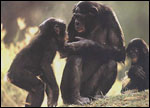Anthropologists to hold meeting in Buffalo
Three
UB faculty members among the 1,000 authors to present research papers
By PATRICIA
DONOVAN
Contributing Editor
When
the American Association of Physical Anthropologists meets in Buffalo
Wednesday through April 13, members of the Department of Anthropology,
which is hosting the event at the Adams Mark Hotel, will be among the
1,000 authors to address a variety of topics in the field.
| |
 |
| |
Pygmy
Chimpanzees (Bonobos) |
| |
|
Primatologist
Carol M. Berman, professor of anthropology, will present her research
findings on the extent to which male-male relationships among bonobos
are dependent upon mother-son relationships.
Bonobos,
a tremendously erotic species, are, along with chimpanzees, our closest
cousins among the apes. Sometimes called "pygmy chimpanzees," they live
in only one section of the Congo River basin in female-centered, egalitarian
groups. The uncommon social structure, sexual behavior and intellectual
capacity of bonobos are held by many anthropologists to offer a unique
glimpse into the roots of human nature.
Berman
has published widely on primate behavior, particularly maternal behavior
and social development; the evolution of animal behavior, and ethological
methods.
Joyce
Sirianni, SUNY Distinguished Teaching Professor in the Department of
Anthropology, is a physical anthropologist whose research interests
lay in craniofacial growth and development, and dental anthropology.
During
the conference's dental anthropology/paleopathology session, she will
address features of enamel microstructures in the teeth of pigtailed
macaques.
Macaques,
the cocker spaniel-sized monkeys most commonly used in medical research,
often are referred to as the second most successful primate. Macaques
have quite complex social and behavioral systems. Their complicated
calls and gestures have been discovered to have specific meanings, and
tool-use and cultural innovations have been observed among them.
Because
of their physical similarity to humans, some macaque biological systems—the
visual, reproductive and immune systems, for instance—have been
used as a model of human systems.
Sirianni's
research includes the study of the similarities in the fetal craniofacial
complex of macaques and humans. She is the author, with Daris R. Swindler,
of "Growth and Development of the Pigtailed Macaque," an atlas of longitudinally
gathered information on the growth and development of Macaca nemestrina.
Ted
Steegman, professor of anthropology, will present a paper on scientific
discipline and intellectual freedom during the late 1950s at the University
of Michigan, from which he received his doctorate in 1965. Steegman
will address the dominating paradigms in physical and cultural anthropology,
archaeology and linguistics at a time when American universities were
enjoying a period of optimism and growth.
"It
was a time," says Steegman, "when the rising intellectual tide was being
expressed at emerging centers of anthropological and biological theory,
like the University of Michigan."
Steegman's
research is in the field adaptive human biology and physical anthropology
in the subarctic, China and Canada.
Other
subjects to be covered at the conference include biodiversity in Northeast
Africa; the nutritional status, physical activity and productivity of
various groups of hominids and non-hominids, past and present; forensic
anthropology; modern morphometric techniques; South African paleoanthropology,
and primate cognitive ecology.

